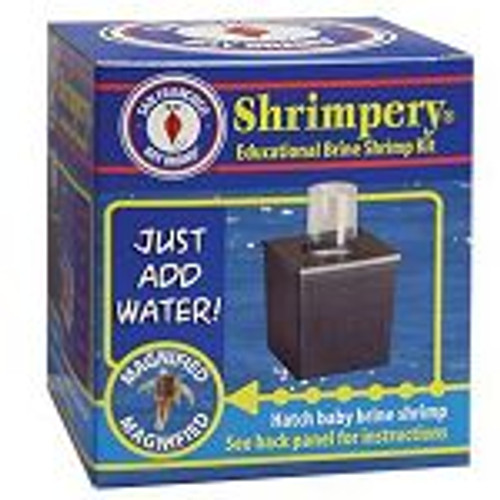Bay Brand Shrimpery, Brine Shrimp Hatchery
Features Grow Your Own Brine Shrimp For all Baby Fish & Reef Tanks Hatch your own fish food or use as an educational tool. Includes 3 packets of hatch mix. Add water and presto! Not intended to raise shrimp to adult size. All Natural Highly nutritious Excellent for fish and reefs Stimulates good growth and enhances the color of your fish
Recommended for :
- Small or Baby Freshwater Fish: Egg Laying, Live Bearing, Platys, Tetras…
- Small Saltwater Fish: Gobies, Blennies…
- Saltwater Invertebrates: Tridacnid Clams, Crabs, Feather Dusters, Shrimps, Sea Apples…
- Corals: SPS, LPS…
Bay Brand Shrimpery, Brine Shrimp Hatchery
Features Grow Your Own Brine Shrimp For all Baby Fish & Reef Tanks Hatch your own fish food or use as an educational tool. Includes 3 packets of hatch mix. Add water and presto! Not intended to raise shrimp to adult size. All Natural Highly nutritious Excellent for fish and reefs Stimulates good growth and enhances the color of your fish
Recommended for :
- Small or Baby Freshwater Fish: Egg Laying, Live Bearing, Platys, Tetras…
- Small Saltwater Fish: Gobies, Blennies…
- Saltwater Invertebrates: Tridacnid Clams, Crabs, Feather Dusters, Shrimps, Sea Apples…
- Corals: SPS, LPS…
Feeding Instructions :
- Empty one pack of Hatch Mix into Shrimpery™.
- Using room temperature tap water fill Shrimpery™ to marker level and collector bottle to brim. Stir contents of Shrimpery until salt is no longer visible at bottom.
- Cover collector bottle and Shrimpery™. Water level should be higher than circular ledge in Shrimpery™ cover. (add water if necessary)
- Place the collector bottle (lid side down) into Shrimpery™ cover. Note: tap top of collector bottle to release air bubble(s) that may be blocking hole in collector lid.
- within 18 to 40 hours (depending upon temperature) brine shrimp, naturally attracted to light will be seen swimming up into the collector bottle*.
- Feed your baby fish from the freshwater in the collection bottle. You may collect additional brine shrimp for as long as 24 hours. (to collect more shrimp as often as every 2 hours simply refill collector bottle with fresh tap water)
- *Only the brine shrimp swim up through the hole and are washed free of salt. The saltwater being heavier than fresh water in the collection bottle stays behind.
Included:
- Shrimpery™ With Lid
- Collection Vial With Lid
- 3 Hatch Mix™ Packets (Brine Shrimp Eggs, Magnesium Sulfate, Sodium Chloride)
Item No. AC-BAY66170
2 Reviews
-
Convenient but inefficient
It works and collection is super convenient but you loose so much, the yield is terrible.
-
Good product. Easy to collect the little guys.
I had a brine shrimp hatchery once a long time ago when I just had freshwater tropical fish. It was a little different than this one. I like parts of it better and I like parts of this one better.<br><br>Pros -- It is very easy to collect the baby brine shrimp from this shrimpery. I fill the collection cup with my tank water and put it onto the shrimpery as the directions state. The babies will swim up into the cup by the hundreds or thousands. I then just pour the entire cup back into my tank and my Xenia, Featherdusters, Zoa's, Corals, Clam and fish get a nice fresh tatsy treat. Even my scooter blenny (dragonette) chases and eats them, but she'll also eat frozen adult brine shrimp<br><br>Cons -- My old shrimp hatchery from a hundred years ago had a hole for inserting airline to an airstone. This one you can put an airline through the collection hole, but it's not held in place and the whole top is very loose, so the hatchery leaks water from around the cover if you aerate. Lots of water. I have mine sitting in a small bucket to contain it.<br><br>I've only had it for a couple of weeks. I'm working on a way to feed the babies so they can grow to adulthood and then maybe enrich them with Selcon. I think I "fed" them the Selcon too early this first batch and may have killed the ones that were left after a few good feedings of babies. I seem to remember from way back when that they recommended feeding the babies hard boiled egg yolk, but I'm old and that could totally be some false memory. I'm going to try it next batch though.



















